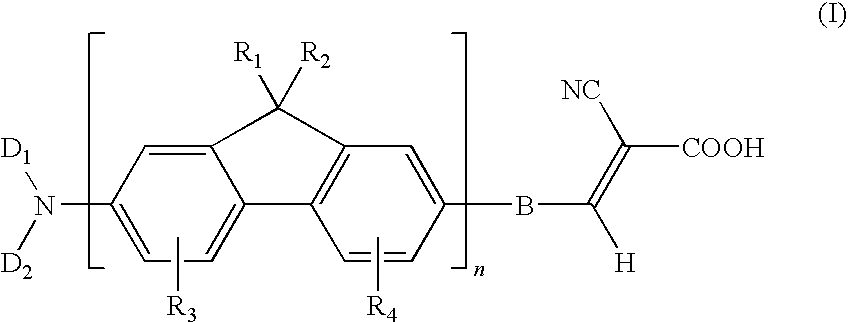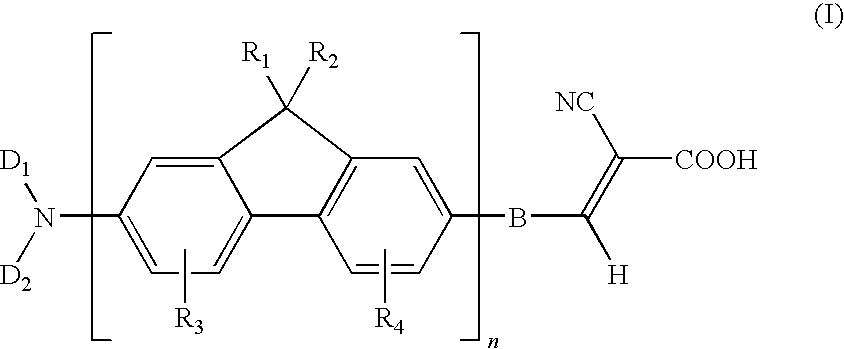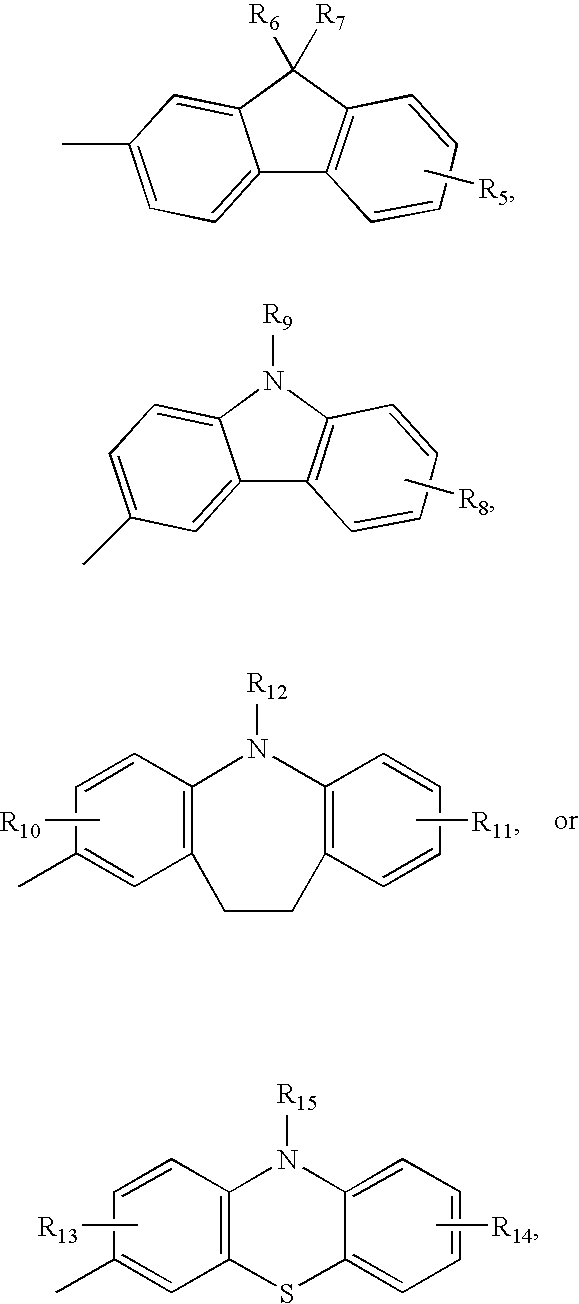Dye compound and photoelectric component using the same
a technology of dye compound and photoelectric component, which is applied in the direction of electrolytic capacitor, organic chemistry, chemistry apparatus and processes, etc., can solve the problems of high manufacturing cost of ruthenium complexes, complex process for synthesis of sensitized dyes, energy crisis and environmental pollution, etc., and achieve high molar absorption coefficient and improve photoelectric conversion efficiency
- Summary
- Abstract
- Description
- Claims
- Application Information
AI Technical Summary
Benefits of technology
Problems solved by technology
Method used
Image
Examples
example 1
Synthesis of (7-bromo-9H-fluoren-2-yl)-dibutylamine (11)
[0051]Under N2 atmosphere, 0.52 parts of 7-bromo-9H-fluoren-2-ylamine, 1.47 parts of 1-iodobutane, and 1.38 parts of potassium carbonate were added into 15 parts of dry dimethylformamide, followed by stirring and mixing. Then, the reaction mixture was heated to 120° C. and reacted for 24 hours. After the reaction mixture was cooled, poured the water into the reaction mixture for quenching the reaction, and using the diethyl ether to extract the product, and magnesium sulfate was used for dehydration. After removing the solvent, the residual was purified with column chromatography method by using dichloromethane / hexane co-solvent as an eluent, to obtain a compound (11) of the present example. This compound was in a form of a yellowish-brown solid, and the yield of this compound was 85%.
example 2
Synthesis of 5-(7-dibutylamino-9H-fluoren-2-yl)-thiophene-2-carbaldehyde (12a)
[0052]Under N2 atmosphere, 0.37 parts of (7-bromo-9H-fluoren-2-yl)-dibutyl amine (11), 0.19 parts of 5-formyl-2-thiopheneboronic acid, 0.41 parts of potassium carbonate, and 0.16 parts of PdCl2(dppf) were added into 5 parts of toluene and 5 parts of CH3OH, followed by stirring and mixing. Then, the reaction mixture was heated to 60° C. and reacted for 18 hours. After the reaction mixture was quenched by water, using the diethyl ether to extract the product, and magnesium sulfate was used for dehydration. After removing the solvent, the residual was purified with chromatography method column by using dichloromethane / hexane co-solvent as an eluent, to obtain a compound (12a) of the present example. This compound was in a form of a tangerine solid, and the yield of this compound was 61%.
example 3
Synthesis of 4-(7-dibutylamino-9H-fluoren-2-yl)-benzaldehyde (12b)
[0053]The process for preparing the dye compound of the present example is the same as that described in Example 2, except that 5-formyl-2-thiopheneboronic acid is substituted with 0.18 parts of 4-formylphenylboronic acid, to obtain a compound (12b) of the present example. This compound was in a form of yellow solid, and the yield of this compound was 53%.
PUM
| Property | Measurement | Unit |
|---|---|---|
| Photoelectricity | aaaaa | aaaaa |
Abstract
Description
Claims
Application Information
 Login to View More
Login to View More - R&D
- Intellectual Property
- Life Sciences
- Materials
- Tech Scout
- Unparalleled Data Quality
- Higher Quality Content
- 60% Fewer Hallucinations
Browse by: Latest US Patents, China's latest patents, Technical Efficacy Thesaurus, Application Domain, Technology Topic, Popular Technical Reports.
© 2025 PatSnap. All rights reserved.Legal|Privacy policy|Modern Slavery Act Transparency Statement|Sitemap|About US| Contact US: help@patsnap.com



